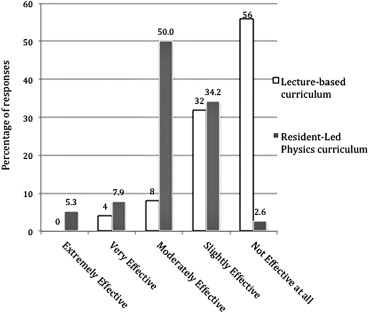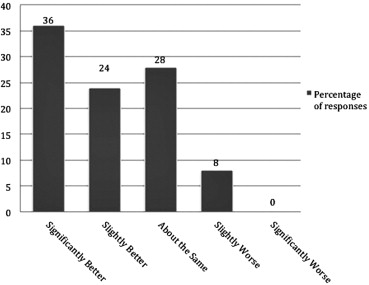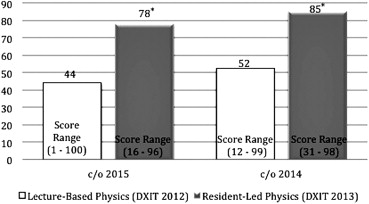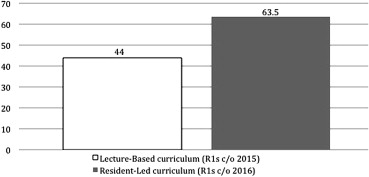Rationale and Objectives
With the impending integration of clinically relevant physics into the new American Board of Radiology Core exam, diagnostic radiology residency programs are faced with the challenge of how best to adapt the teaching of radiologic physics to residents. We present a novel resident-led physics curriculum that replaces the traditional didactic structure used in previous years. The hypothesis is that a self-teaching curriculum will facilitate greater retention of core physics concepts and foster a mentality of independent learning. We present both the implementation of this new curriculum and the initial outcomes.
Materials and Methods
A 2-year resident-led physics curriculum was designed and implemented, with integration of the Radiological Society of North America/American Association of Physicists in Medicine online Physics Modules. A preimplementation survey was completed by residents to assess opinions on the previous lecture-based didactic curriculum. A postimplementation survey was then administered six months into the new resident-led curriculum. DXIT Physics percentile scores were compared before and after the curriculum change. The outcomes analysis of this study was approved by the University of Pittsburgh Institutional Review Board and issued IRB approval #PRO13050022.
Results
Average Physics DXIT percentile scores improved by 24.1% after the implementation of the resident-led curriculum. Results from the postimplementation survey reveal that 36% of residents think the change was a “Significant Improvement” in physics education. Also, 50% of responses have rated the new curriculum as “Moderately” effective, and an additional 13% of responses have rated the curriculum as “Very-to-Extremely” effective in teaching physics.
Conclusions
Compared to our prior lecture-based physics curriculum, the change to a resident-led physics curriculum, to teach clinically relevant physics concepts to radiology residents, has been both effective and well received.
A sound foundation in radiologic physics is essential to understanding imaging technology. Since its inception in 1934, the American Board of Radiology (ABR) has affirmed the importance of physics in its certifying exams. Physics certification first took the form of a dedicated oral physics examination and was eventually transitioned to a written physics examination in 1969. This written physics exam was initially administered during the fourth year of training, but 30 years later, in an effort to provide greater flexibility, testing was permitted following the first year of training. The vast majority of programs soon promoted testing at the earliest opportunity. This more progressive timeline had the inevitable consequence of permitting certification before a trainee encountered the actual physics concepts clinically .
Anecdotally, for many residents, physics education is often perceived as irrelevant or simply as a hurdle to be crossed and forgotten. Partially to combat this trend, the ABR will alter its process of certification again in 2013 when the written exam is assimilated into the new ABR Core examination. This exam replaces the written and oral exams with a single, image-rich computer exam spanning 18 competencies of radiology. Physics principles have been incorporated into clinical imaging scenarios throughout the exam . Furthermore, physics concepts will now be stressed during the Maintenance of Certification exams, taken throughout every radiologist’s career.
Get Radiology Tree app to read full this article<
Get Radiology Tree app to read full this article<
Get Radiology Tree app to read full this article<
Materials and methods
Curriculum Implementation
Get Radiology Tree app to read full this article<
Get Radiology Tree app to read full this article<
Get Radiology Tree app to read full this article<
Table 1
Abridged Sample Curriculum for Classes 2014–2016 ∗
Academic Year 2012–2013 End of Module Question Assignment § Presenter ‡ Date Module Facilitator † Module Dedline 1 2 3 Resident A 7/17/12 1. Atoms, Radiation, Radioactivity Facilitator A 8/31/12 Resident 1 Resident 2 Resident 3 Resident B 7/17/12 2. Interactions of Radiation and Tissue Facilitator A Resident 3 Resident 5 Resident 7 Resident C 8/14/12 3. Radiation Measurements and Units Facilitator B 8/31/12 Resident 4 Resident 2 Resident 12 Resident D 8/14/12 4. X-Ray Tubes and Spectra Facilitator B Resident 5 Resident 11 Resident 1 Resident E 9/18/12 6. Evaluation of Image Quality Facilitator C 10/31/12 Resident 6 Resident 1 Resident 2 Resident F 9/18/12 7. Image Display Facilitator C Resident 7 Resident 5 Resident 6
Get Radiology Tree app to read full this article<
Get Radiology Tree app to read full this article<
Get Radiology Tree app to read full this article<
Get Radiology Tree app to read full this article<
Get Radiology Tree app to read full this article<
Get Radiology Tree app to read full this article<
Measuring Outcomes
Get Radiology Tree app to read full this article<
Get Radiology Tree app to read full this article<
Get Radiology Tree app to read full this article<
Get Radiology Tree app to read full this article<
Results
Get Radiology Tree app to read full this article<
Get Radiology Tree app to read full this article<
Get Radiology Tree app to read full this article<
Get Radiology Tree app to read full this article<
Table 2
Table of Responses to the Post-implementation Survey Question “Please Rate How Helpful the Following Components of the Resident-led Physics Course Have Been for You” ∗
Rating Scale 1 2 3 4 5 Not helpful Somewhat helpful Very helpful Preparing and delivering a lecture † 1 (5.8%) 2 (11.8%) 1 (5.8%) 6 (35.3%)7 ( 41.2%) Working through RSNA/AAPM Physics modules before class 2 (5.3%) 2 (5.3%) 8 (21.1%)15 ( 39.5%) 11 (28.9%) Going over Physics Modules during lecture 4 (10.5%) 6 (15.8%) 5 (13.2%)13 ( 34.2%) 10 (26.3%) Input from faculty facilitators 0 1 (2.6%) 13 (34.2%)16 ( 42.1%) 8 (21.1%) Going through end of module questions 2 (5.3%) 4 (10.5%) 7 (18.4%)15 ( 39.5%) 10 (26.3%)
Get Radiology Tree app to read full this article<
Get Radiology Tree app to read full this article<
Get Radiology Tree app to read full this article<
Get Radiology Tree app to read full this article<
Get Radiology Tree app to read full this article<
Get Radiology Tree app to read full this article<
Get Radiology Tree app to read full this article<
Discussion
Implementation and Early Outcomes
Get Radiology Tree app to read full this article<
Get Radiology Tree app to read full this article<
Get Radiology Tree app to read full this article<
Get Radiology Tree app to read full this article<
Get Radiology Tree app to read full this article<
Potential Limitations
Get Radiology Tree app to read full this article<
Get Radiology Tree app to read full this article<
Get Radiology Tree app to read full this article<
Future Directions
Get Radiology Tree app to read full this article<
Get Radiology Tree app to read full this article<
Get Radiology Tree app to read full this article<
Acknowledgments
Get Radiology Tree app to read full this article<
References
1. Hendee W.R.: An opportunity for radiology. Radiology 2006; 238: pp. 389-394.
2. American Board of Radiology. Preparing for Medical Physics Components of the ABR Core Examination. http://www.theabr.org/sites/all/themes/abr-media/pdf/Physics.pdf . Accessed May 19, 2013.
3. Radiological Society of North America. AAPM/RSNA physics tutorials for residents. Radiological Society of North America Website. www.rsna.org/RSNA/AAPM_Online_Physics_Modules_.aspx . (Accessed May 19, 2013).
4. American Association of Physicists in Medicine. Diagnostic radiology residents physics curriculum. Available online: http://www.aapm.org/education/documents/Curriculum.pdf (Accessed May 19, 2013).
5. Hendee W.R.: Web based modules for physics education of radiology residents. J Am Coll Radiol 2010; 7: pp. 306-308.
6. Nachiappan A.C., Lee S.R., Willis M.H., et. al.: Clinically oriented three-year medical physics curriculum: a new design for the future. AJR Am J Roentgenol 2012; 199: pp. 635-643.
7. Hendee W.R.: Teaching physics to radiology residents. AJR Am J Roentgenol 2009; 192: pp. 855-858.
8. Nachiappan A.C., Wynne D.M., Katz D.P., et. al.: A proposed medical physics curriculum: preparing for the 2013 ABR Examination. J Am Coll Radiol 2011; 8: pp. 53-57.
9. Hendee W.R.: Improving physics education in radiology. J Am Coll Radiol 2007; 4: pp. 555-559.
10. Shankar, P, Heller M, Woodard J, Orons P. Development of a Resident-led Physics Curriculum with Integration of the RSNA/AAPM Physics Modules. Poster session presented at 61st Annual Meeting Association of University Radiologists; 2013 April 9-12; Los Angeles, CA.



